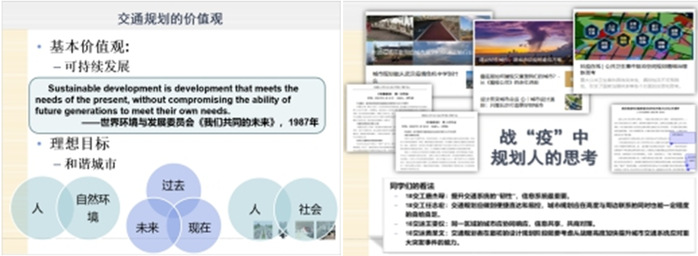Recently, in the Collection of Excellent Online Teaching Cases during the Epidemic Phase organized by the Steering Committee of Online Open Courses for Undergraduate Universities in Guangdong Province, Dr. Ma Yingying and Dr. Lin Yongjie from the Traffic Engineering Department won the first prize in the course category with their online teaching case Online Teacher and Student Face to Face, Zero Distance for Multiple Teaching, which was based on the course Transportation Planning, among the 683 cases from 58 universities.
The course Transportation Planning is an offline course for students of traffic engineering and transportation majors in our university, and in 2020, due to the epidemic, the course was switched to online teaching. The features and innovations of the case are as follows.
1. Curriculum thinking on values formation and professionalism. After introducing the main content of the course by teachers, students will discuss on the principle values of transport planning which is able to gradually guide them to establish the planning values of sustainable development and the ideal goal of building a harmonious city, and enriching their understanding of the core socialist values by giving examples of how they are reflected in transportation planning.
2. Guiding students to link knowledge to practice through Social Hotspots and Professional Practice. The course takes into account the 2020 Newcastle Pneumonia epidemic and leads students to carry out social practice activities with the themes of Response of Urban Planning and Transportation Planning to Major Public Health Events and Investigation and Analysis of the Impact of Major Health Events on Urban Traffic Behavior through the distribution of reading materials, class discussions, organization of surveys and writing of research reports.

3. Students take the lead in the classroom through student presentations, online questions and group discussions. Through video conferencing, all students are invited to give presentations, ask questions and discuss according to the prearranged topics related to the course.
4. Comprehensive on-line guidance through Offline guidance document, online operation demonstration and online Q&A. For the on-line guidance of the course, electronic task books and guidance books are issued, online operation demonstration and on-site Q&A are conducted through video conferencing, and on-line operation Q&A is conducted through the online platform after the class.
5. Real online classroom through offline board book, live video broadcast and message area interaction. For the course is particularly difficult to understand and need to be derived from mathematical formulae of the traffic distribution model, the use of offline blackboard book video broadcast derivation process, the use of colored pens to distinguish the key points and difficulties, simultaneous live with the online classroom camera, and through the message area question and answer for teacher-student interaction.

6. Take full advantage of the online homework system through Online submission and marking of corrections. The homework system is used to assign and receive students' coursework, and to mark and fill in comments online, so as to achieve effective feedback on the homework after the class.
During the epidemic, the college responded positively to the requirements of the Central Committee of the Party on stopping classes without teaching and learning and, in accordance with the overall plan of the university, made full use of technology and information technology to transfer offline face-to-face teaching to online classes, and resolutely fought the teaching battle in the face of the epidemic. With the normalization of epidemic prevention and control, the college will further summarize its online teaching experience, carry out in-depth construction of curriculum thinking and teaching mode reform, and continuously improve the quality of undergraduate teaching.
